1980
| Record of unexpected wintering species continued to
accumulate: in
winter 1979-1980 the State had its first wintering Sharp-tailed
Sandpiper
(Jan-Mar at Pt. Mugu; Richard E. Webster), Willow Flycatcher
(Nov-Mar
at Arcadia, L.A.; Barbara Cohen), and two Grace's Warblers
(Dec-Mar
in Santa Barbara; Louis Bevier, Paul Lehman). These were the first to
winter
anywhere in the U.S. In late winter, Guy McCaskie found a Black
Rosy-Finch
among 1500 rosy-finches in Mono County, the first northern California
record
in almost a century.
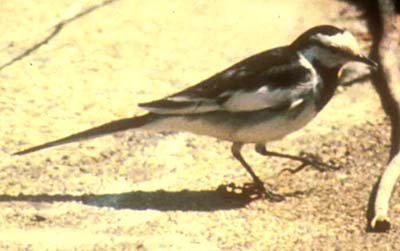 Notable
waders in spring migration were northern California's first spring Buff-breasted
Sandpiper (3-4 May at Arcata; Ron LeValley) and the State's third
(and
first chasable)
Hudsonian Godwit at Edwards AFB, L.A. (9-19 May;
Jon Dunn). A Sandwich Tern — a first State record; indeed, the
first
for the western U.S. — appeared in the Elegant Tern colony on San Diego
Bay 11-15 May (Fred Schaeffner). At Tiburon in Marin County, a
breeding-plumaged
male Black-backed Wagtail made a one-day visit 22 May (photo
left,
© Phil Schaeffer). This was before the AOU split the White Wagtail
complex; it was the 2nd State record for lugens. The State's
first
had been the previous August, and that bird (a female) returned to
Watsonville
on the SCZ/MTY border from 20 July-21 Sep. Other interesting summer
birds
included a Heermann's Gull nesting attempt on Alcatraz I. in
San
Francisco Bay (the first attempt ever in the U.S.; L.C. Binford) and
breeding
success for Little Blue Heron at Alviso in south San Francisco
Bay. Notable
waders in spring migration were northern California's first spring Buff-breasted
Sandpiper (3-4 May at Arcata; Ron LeValley) and the State's third
(and
first chasable)
Hudsonian Godwit at Edwards AFB, L.A. (9-19 May;
Jon Dunn). A Sandwich Tern — a first State record; indeed, the
first
for the western U.S. — appeared in the Elegant Tern colony on San Diego
Bay 11-15 May (Fred Schaeffner). At Tiburon in Marin County, a
breeding-plumaged
male Black-backed Wagtail made a one-day visit 22 May (photo
left,
© Phil Schaeffer). This was before the AOU split the White Wagtail
complex; it was the 2nd State record for lugens. The State's
first
had been the previous August, and that bird (a female) returned to
Watsonville
on the SCZ/MTY border from 20 July-21 Sep. Other interesting summer
birds
included a Heermann's Gull nesting attempt on Alcatraz I. in
San
Francisco Bay (the first attempt ever in the U.S.; L.C. Binford) and
breeding
success for Little Blue Heron at Alviso in south San Francisco
Bay.
Three new State birds headlined the autumn migration,
two of them from
Siberia: a Mongolian Plover [Lesser Sandplover] at Moss
Landing,
Monterey Co., 13-19 Sep (Carol Deuel, Donna Dittmann), a Dusky
Warbler
— California's first Phylloscopus warbler — captured on SE
Farallon
I. 27 Sep (like a Dusky Warbler netted over 20 years later, it arrived
with no fat and was so weak it died in the hand), and a Sedge Wren
(then called "Short-billed Marsh Wren") at Bolinas 4-8 Nov (Dave
DeSante).
Other notables of the fall were the first 'chasable' Black-billed
Cuckoo
at Pt. Reyes 8-14 Sep (John Luther; 4th Calif. record), and the return
of the famous (or infamous) Skylark at Pt. Reyes on 25 Oct (see
the 1979 account). At Morro Bay, Gary Page found California's third Piping
Plover 1 Oct. It would linger to 15 Dec; there has not been
another
one since then.
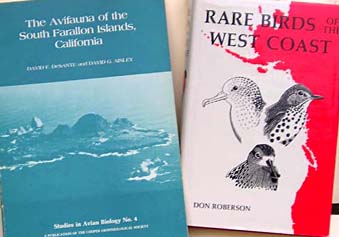 Two
useful and influential books appeared in 1980 (photo right).
The
Avifauna of the South Farallon Islands (1980) by David F.
DeSante
and David G. Ainley summarized all that had been learned to date from
those
magic rocks. Seabirds and the influence of the marine environment were
detailed, as were all the wayward vagrants to date and a summary of
DeSante's
misorientation work. The book was scholarly and professional. Somewhat
different was Rare Birds of the West Coast (1980) by Don
Roberson. A compendium of records, maps, graphs and photos of west
coast
rarities from Alaska to California, plus much distilled identification
material, it captured some of the enthusiasm for vagrant birds that had
been at the heart of the previous decade. But it was very much homemade
with hand-drawn graphs, hand-placed dots, and some inscrutable
photographs.
Paul Buckley & Will Russell, writing of the "American scene" for a
British audience in British Birds (Vol. 75: 555; 1982),
summarized:
"The painted plates range from not-at-all-bad ... to better-left-undone
. . . The text is shot through with black-and-white photos, often of
tiny
size, some that were too poor for printing, and with a few where we
truly
could not discern, let alone identify, the bird. Notwithstanding, it is
a useful book, a splendid introduction to rarities along the west coast
of North America, many of which are likely in Britain and Ireland." Two
useful and influential books appeared in 1980 (photo right).
The
Avifauna of the South Farallon Islands (1980) by David F.
DeSante
and David G. Ainley summarized all that had been learned to date from
those
magic rocks. Seabirds and the influence of the marine environment were
detailed, as were all the wayward vagrants to date and a summary of
DeSante's
misorientation work. The book was scholarly and professional. Somewhat
different was Rare Birds of the West Coast (1980) by Don
Roberson. A compendium of records, maps, graphs and photos of west
coast
rarities from Alaska to California, plus much distilled identification
material, it captured some of the enthusiasm for vagrant birds that had
been at the heart of the previous decade. But it was very much homemade
with hand-drawn graphs, hand-placed dots, and some inscrutable
photographs.
Paul Buckley & Will Russell, writing of the "American scene" for a
British audience in British Birds (Vol. 75: 555; 1982),
summarized:
"The painted plates range from not-at-all-bad ... to better-left-undone
. . . The text is shot through with black-and-white photos, often of
tiny
size, some that were too poor for printing, and with a few where we
truly
could not discern, let alone identify, the bird. Notwithstanding, it is
a useful book, a splendid introduction to rarities along the west coast
of North America, many of which are likely in Britain and Ireland."
|
|
1981
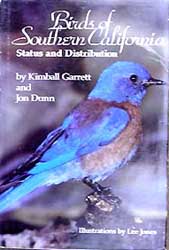 1981
was the first of three years during the '80s when shorebirds dominated
birders' conversations. These would come in summer and fall, however.
The
first half of the year was rather quiet. In one of those Twilight
Zone-like
episodes, Dick Erickson & Steve Summers had a Blue-footed Booby
fly past them on 16 Jan as they scoped for Pt. St. George, the
northernmost
scoping point in California. And the booby was heading south . . . At
the
very end of the year (30 Dec), Richard Webster had a similarly
unexpected
encounter: a Mottled Petrel flew by Pt. Mugu, Ventura Co., as
he
scoped. It was the first live one ever seen in the State, all others
having
washed up dead on beaches. Until the waders arrived, about the only
other
major highlights were a singing White-eyed Vireo in Whitewater
Canyon,
Riverside Co. (9 May for 5th CA record; Lee Jones) and a LeConte's
Sparrow
at Furnace Creek Ranch 24-25 May (5th s. CA record but 4th one at this
spot). 1981
was the first of three years during the '80s when shorebirds dominated
birders' conversations. These would come in summer and fall, however.
The
first half of the year was rather quiet. In one of those Twilight
Zone-like
episodes, Dick Erickson & Steve Summers had a Blue-footed Booby
fly past them on 16 Jan as they scoped for Pt. St. George, the
northernmost
scoping point in California. And the booby was heading south . . . At
the
very end of the year (30 Dec), Richard Webster had a similarly
unexpected
encounter: a Mottled Petrel flew by Pt. Mugu, Ventura Co., as
he
scoped. It was the first live one ever seen in the State, all others
having
washed up dead on beaches. Until the waders arrived, about the only
other
major highlights were a singing White-eyed Vireo in Whitewater
Canyon,
Riverside Co. (9 May for 5th CA record; Lee Jones) and a LeConte's
Sparrow
at Furnace Creek Ranch 24-25 May (5th s. CA record but 4th one at this
spot).
In summer, Guy McCaskie wrote that "The most
significant event [of the
season] was the appearance of the long-awaited Birds of Southern
California (right) by Kimball Garrett and Jon Dunn . . . which
gives us a summary of the status and distribution of all 500+ species
occurring
in [southern California] through 1980." Garrett & Dunn (1981) would
remain the standard text on the birds of southern California for years
to come. Another important publication in 1981 was Joe Morlan's "Status
and identification of forms of White Wagtail in western North America,"
which appeared in the short-lived journal Continental Birdlife
[vol.
2: 37-50]. It was the first serious attempt to work out the i.d. of the
wagtails that reach California, and the translation of a Russian text,
undertaken for this paper, was instrumental in the eventual A.O.U.
decision
to split Black-backed from White Wagtail.
Two first State records appeared in summer 1981. A
Least Auklet
was found barely alive on a San Mateo County beach 16 June, and it
expired
at the local SPCA. This remains the only California record (to 2005).
Then
Jon Dunn discovered a breeding plumaged Gray-tailed Tattler
(called
"Polynesian Tattler" back then) near Lancaster, L.A. Co., 23 July; a
one-day
wonder that was photographed. This would prove to be a very fine year
for
Siberian shorebirds. The State's first chasable Rufous-necked Stint
was an adult at the Santa Clara R. mouth (McGrath S.B.), Ventura Co.,
12-17
July (Ed Navajosky, Dave Koeppel; 3rd CA rec; photo © D. Roberson
below
left). Then Guy McCaskie found the first of four (!) different
Curlew
Sandpipers this autumn migration: at San Elijo Lagoon, San Diego
County,
4 July (photo below right; © Herb Clarke).
|
The others would appear in northern California: molting adult 1 Aug at
Año Nuevo, San Mateo Co. (Don Schmoldt), juv 28-29 Sep at Ft.
Dick,
Del Norte Co. (Dick Erickson, Ron LeValley, Gary Lester), and molting
adult
31 Oct-1 Nov at Fernbridge, Humboldt Co. (J. Kelly).
 The
fall also had a number of landbird highlights. An Olivaceous
Cormorant
was found at Imperial Dam on the Colorado River 7 Sep (Mark Kasprzyk)
for
just the 2nd State record; it stayed a month to be enjoyed by all the
hardcore
State listers. Kimball Garrett had a Cerulean Warbler in
Yosemite
Valley on 12 Oct, surely among the places it would have been least
expected!
Another on S.E. Farallon I. made better sense. A Wood Thrush at
Pt. Loma, San Diego, 24 Oct-5 Nov (Brian Daniels) was the State's
fifth,
but the absolute high point was McCaskie's discovery of a Baird's
Sparrow
at Pt. Loma on 5 Oct (photo left © D. Roberson). This was
only
the second for California (the first having been on the Farallones) and
the bird itself so tame and bewildered that it actually stepped on the
shoes of curious birders! The
fall also had a number of landbird highlights. An Olivaceous
Cormorant
was found at Imperial Dam on the Colorado River 7 Sep (Mark Kasprzyk)
for
just the 2nd State record; it stayed a month to be enjoyed by all the
hardcore
State listers. Kimball Garrett had a Cerulean Warbler in
Yosemite
Valley on 12 Oct, surely among the places it would have been least
expected!
Another on S.E. Farallon I. made better sense. A Wood Thrush at
Pt. Loma, San Diego, 24 Oct-5 Nov (Brian Daniels) was the State's
fifth,
but the absolute high point was McCaskie's discovery of a Baird's
Sparrow
at Pt. Loma on 5 Oct (photo left © D. Roberson). This was
only
the second for California (the first having been on the Farallones) and
the bird itself so tame and bewildered that it actually stepped on the
shoes of curious birders!
A number of species would winter in California in
1981-82 for the first
time: Pectoral Sandpiper at Salton Sea (20 Feb-6 Mar 1982, G.
McCaskie,
E. Cardiff), Bay-breasted Warbler and Mourning Warbler
at
Long Beach, Los Angeles Co. (Brian Daniels, found in January &
December,
respectively), and Worm-eating Warbler wintered for the 2nd
time
(also Long Beach 6 Nov-21 Mar; K.L. Garrett). And the year ended with a
Siberian surprise: Barry Sauppe found a male Smew at Foster
City
on the Crystal Springs Christmas Count 19 Dec; it was a first State
record
and would linger to mid-February, and then return for two more winters.
|
|
1982

| Birders at Gyrfalcon, 23 Jan 1982
(photo © D. Roberson);
among those shown (L to R) are Arnold Small, Mike Parmeter (both in red
caps), Dan Singer, Bruce LaBar (at scope), Steve Bailey (hidden behind
scope), Guy McCaskie (making a point), Bruce Broadbooks (white cap),
and
John Luther (blue vest) |
 After
"everyone" had chased the Smew in December, another chase congregated
the
multitudes in January 1982. A falconer exercising his Goshawk near
Davis,
Yolo County, was startled when a wild Gyrfalcon dived at his
hawk
on 17 Jan; it took several days for the bird to be confirmed and word
to
spread, but California's first chasable Gyr remained to 8 Feb (the one
previous record was a specimen from 1948). The fine photo (left)
is by Peter LaTourrette. After
"everyone" had chased the Smew in December, another chase congregated
the
multitudes in January 1982. A falconer exercising his Goshawk near
Davis,
Yolo County, was startled when a wild Gyrfalcon dived at his
hawk
on 17 Jan; it took several days for the bird to be confirmed and word
to
spread, but California's first chasable Gyr remained to 8 Feb (the one
previous record was a specimen from 1948). The fine photo (left)
is by Peter LaTourrette.
A new California species in March was a Barred Owl
in Redwood
N.P. near Crescent City, Del Norte Co. (12 Mar; Dick Erickson). The
second
State record was in Trinity County in August and the invasion was
launched.
At this writing (2005), Barred Owl has spread south to Marin County.
Among
unexpected birds in spring were a Sharp-tailed Sandpiper near
Lancaster,
L.A. Co. (5-9 May, Jon Dunn; 1st spring rec for CA) and an adult male Scarlet
Tanager on Pt. Reyes 20 June (Joe Morlan; 10th regional rec but
only
2nd adult male), but in the stratosphere of the unexpected was a White-collared
Swift foraging over Pt. St. George, Del Norte Co., 21 May, for
another
State first (Dick Erickson, Gary Lester et al.). Summer was rather
uneventful,
save reappearances by last year's Red-necked Stint (McGrath
S.B.,
Ventura Co.) and the elusive Sandwich Tern in San Diego, until
the
State's 2nd Lesser Sandplover (Mongolian Plover) was found at
McGrath
from 7-13 Aug (Andy Starrett).
California's fourth Streaked Shearwater was on
Monterey Bay 26
Sep (Alan Baldridge, Joe Morlan). The next day (27 Sep), as the
remnants
of Hurricane Olivia made landfall at San Diego, Richard Webster
saw a subadult Sooty Tern pass by the San Diego R. mouth. This
was
a first California record and the first to be accepted from a single
observer's
description (without photos); several other Sooty Terns have occurred
since
then. The rest of the fall was comparatively quiet, although wintering
warblers continued to make news: a Prothonotary wintered in the
Loleta Bottoms, Humboldt Co. (John Sterling et al.) and two Prairie
Warblers wintered on the central California coast: in Pacific
Grove,
Monterey Co. (Alan Baldridge) and Half Moon Bay, San Mateo Co. (Peter
J.
Metropolus). When a Yellow-throated Warbler was found freshly
dead
in Santa Monica, L.A. Co., in early January 1984, it would constitute
the
35th warbler to be found in winter in the Golden State.
 A
major El Niño event began this winter in the eastern tropical
Pacific,
but its impacts would not be felt in California for months. In the end,
it would have worldwide impact, causing flood and famine and, in the
Pacific,
intense disruption of seabird breeding and distribution. In the end, it
would be the greatest El Niño of the century, upsetting the
entire
Pacific Basin ecology and spinning tropical vagrants northward. But
that
was in the future. Strangely enough, winter 1982-83 would see a
movement
of cold-water eiders south along the California coast, five of them King
Eiders for the first major incursion in years, including the first
adult male south of Alaska at Imperial Beach & Coronado, San Diego
Co., 4 Dec-25 Jan (Mary Beth Stowe). A
major El Niño event began this winter in the eastern tropical
Pacific,
but its impacts would not be felt in California for months. In the end,
it would have worldwide impact, causing flood and famine and, in the
Pacific,
intense disruption of seabird breeding and distribution. In the end, it
would be the greatest El Niño of the century, upsetting the
entire
Pacific Basin ecology and spinning tropical vagrants northward. But
that
was in the future. Strangely enough, winter 1982-83 would see a
movement
of cold-water eiders south along the California coast, five of them King
Eiders for the first major incursion in years, including the first
adult male south of Alaska at Imperial Beach & Coronado, San Diego
Co., 4 Dec-25 Jan (Mary Beth Stowe).
Also to have worldwide impacts was the publication in
Britain of Peter
J. Grant's Gulls: a Guide to Identification (right), the
first major identification publication on gulls since Jonathan Dwight's
tome for museum-based ornithologists back in 1925. It covered the gulls
of Europe, the Middle East, and eastern North America which, from a
California
viewpoint, meant it covered nearly all our vagrant species. It was the
first identification book aimed at field observers that emphasized
ageing
as the first key to identification. The second edition, published in
1986,
expanded coverage to all North American and Eurasian species. While
today
(2005) we can quibble with details of molt schedules and age
terminology,
it is my opinion that the publication of Grant's two editions on Gulls,
and the papers showcasing Lars Jonsson's stint paintings (see 1984),
were
the most important and influential publications on bird identification
since Roger Tory Peterson invented the field guide back in 1934.
|
|
1983
| A Rufous-backed Robin was found 1 Jan in Costa
Mesa, Orange
Co. (Mark C. Miller; photo, below left, © Don Hoechlin);
it
would be joined by another on 1 Feb and both wintered, with one
lingering
to 11 Apr. These were just the 3rd & 4th State records, and the
first
on the coast; chasable for many. Yet another would be found in fall at
Furnace Creek Ranch in Death Valley (5 Nov; Richard Webster). At the
other
end of the State, 803 miles away by car from Orange County's robins (an
estimated 13 hour drive), California's first Steller's Eider
appeared
in Crescent City harbor on 16 Jan, and would remain through May (found
independently by Jim Rooney & Dick Erickson; photo, below right,
© Jim Rooney). Last year's Smew also returned, so there
were
plenty of nice birds scattered about.
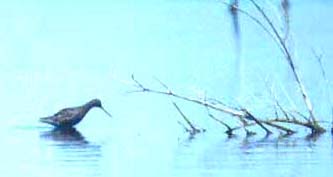 An
alternate-plumaged Spotted Redshank at the north end of the
Salton
Sea (photo left © D. Roberson) was the talk of the spring
(30
Apr-6 May; Dale Delaney, Arnold Small); it was another first State
record.
Last year's Lesser Sandplover returned to McGrath S.B. in July,
but more exciting was a singing Eastern Wood-Pewee at
Manteca,
San Joaquin Co., 18 Aug-7 Sep (David Yee). This was the first Eastern
Wood-Pewee
to be non-controversial in the State (sonograms were published from
recordings
made by Jeri M. Langham). California's 5th Yellow Wagtail was
in
coastal Santa Cruz Co. 4-6 Sep (Carolyn Fredricksen, Bruce LaBar, Dan
Singer),
nicely within the narrow early September timeframe established by prior
records, but this was chasable and seen by most of the State's active
birders.
A good many also saw the State's first Little Stint at Bolinas
14-22
Sep (David H. Edwards). Identification of this juvenal-plumaged bird
was
controversial until photos were vetted by European experts Lars Jonsson
and Peter Grant. Northern California had its first Brown Booby
(on
the Farallones 24-28 Sep) and a Wedge-rumped Storm-Petrel was
in
the Monterey Bay storm-petrel rafts 2-9 Oct (Rich Stallcup, Jeri M.
Langham).
A female Anhinga at Lee Lake, Riverside Co., in late November
would
linger for months, constituting a 3rd California record. Joe Morlan
found
a Wood Thrush in Golden Gate Park, San Francisco, on 21 Dec
that
would remain until 23 Mar 1984, the first Wood Thrush to winter in
California.
And wintering warblers continued to pile up; this time they were Kentucky
Warblers, wintering in Orange and Santa Barbara counties (Robb
Hamilton,
Curtis Marantz). An
alternate-plumaged Spotted Redshank at the north end of the
Salton
Sea (photo left © D. Roberson) was the talk of the spring
(30
Apr-6 May; Dale Delaney, Arnold Small); it was another first State
record.
Last year's Lesser Sandplover returned to McGrath S.B. in July,
but more exciting was a singing Eastern Wood-Pewee at
Manteca,
San Joaquin Co., 18 Aug-7 Sep (David Yee). This was the first Eastern
Wood-Pewee
to be non-controversial in the State (sonograms were published from
recordings
made by Jeri M. Langham). California's 5th Yellow Wagtail was
in
coastal Santa Cruz Co. 4-6 Sep (Carolyn Fredricksen, Bruce LaBar, Dan
Singer),
nicely within the narrow early September timeframe established by prior
records, but this was chasable and seen by most of the State's active
birders.
A good many also saw the State's first Little Stint at Bolinas
14-22
Sep (David H. Edwards). Identification of this juvenal-plumaged bird
was
controversial until photos were vetted by European experts Lars Jonsson
and Peter Grant. Northern California had its first Brown Booby
(on
the Farallones 24-28 Sep) and a Wedge-rumped Storm-Petrel was
in
the Monterey Bay storm-petrel rafts 2-9 Oct (Rich Stallcup, Jeri M.
Langham).
A female Anhinga at Lee Lake, Riverside Co., in late November
would
linger for months, constituting a 3rd California record. Joe Morlan
found
a Wood Thrush in Golden Gate Park, San Francisco, on 21 Dec
that
would remain until 23 Mar 1984, the first Wood Thrush to winter in
California.
And wintering warblers continued to pile up; this time they were Kentucky
Warblers, wintering in Orange and Santa Barbara counties (Robb
Hamilton,
Curtis Marantz).
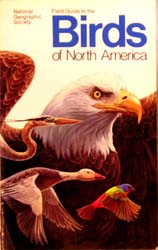 For
many birdwatchers across the continent, the year's biggest event was
the
publication of the National Geographic's Field Guide to the
Birds
of North America (right). Until it appeared in late 1983, the
primary
field guides were Roger Tory Peterson's Western Birds field
guide
(last updated 1961) or Chandler Robbins et al's' Birds of North
America,
illustrated by Arthur Singer, that appeared in 1966. Both were aimed at
beginning birdwatchers. The new National Geographic guide was targeted
at intermediate birders — including the ever-growing contingent of
those
who chased rarities throughout the ABA area (=continental U.S. and
Canada)
— and this audience loved the new guide. It was a major step forward in
field guides, largely attributable to California's own Jon Dunn, one of
the "chief consultants," and input from eastern experts like Claudia
Wilds.
Thirteen artists contributed plates, so the art was inevitably uneven
between
groups of birds, but included some nice work by Doug Pratt, Cindy
House,
and John P. O'Neill. For
many birdwatchers across the continent, the year's biggest event was
the
publication of the National Geographic's Field Guide to the
Birds
of North America (right). Until it appeared in late 1983, the
primary
field guides were Roger Tory Peterson's Western Birds field
guide
(last updated 1961) or Chandler Robbins et al's' Birds of North
America,
illustrated by Arthur Singer, that appeared in 1966. Both were aimed at
beginning birdwatchers. The new National Geographic guide was targeted
at intermediate birders — including the ever-growing contingent of
those
who chased rarities throughout the ABA area (=continental U.S. and
Canada)
— and this audience loved the new guide. It was a major step forward in
field guides, largely attributable to California's own Jon Dunn, one of
the "chief consultants," and input from eastern experts like Claudia
Wilds.
Thirteen artists contributed plates, so the art was inevitably uneven
between
groups of birds, but included some nice work by Doug Pratt, Cindy
House,
and John P. O'Neill.
Despite a new edition of Peterson's Western Birds
guide (1990),
the
National Geographic field guide would become the standard
guide carried by most active birders for the next 17 years. It, too,
went
through several new editions — some substantive and others mostly
cosmetic
— until its popularity was supplanted by the publication of The
Sibley
Guide to Birds by David A. Sibley in 2000.
Also published in 1983 was Peter Harrison's Seabirds:
an Identification
Guide. While based on much original research at sea and ambitious
in
its coverage of all the world's seabirds, it was so ridden with errors,
large and small, as to create almost as many problems as it solved. The
information on seabirds that occur in California was often weak or
simply
wrong, and it had many problems with difficult groups like 'Cookilaria'
petrels, boobies, and frigatebirds. The pages on gulls were light-years
behind Grant's book. Yet it remains popular — and especially so the
photo
guide, published in 1987, that corrected some errors — simply because
it
was the only serious effort to deal with all the world's seabirds in a
single book.
One other event in 1983 deserves mention. Texas had
garnered notoriety
the preceding year when a crack team of experts, plus the legendary
Roger
Tory Peterson, used a Lear jet to set a national Big Day record in
Texas:
235 species in a single calendar day. In 1983, a Texas team was to
attempt
to enlarge on this record but the National Audubon Society decided to
sponsor
a competing team of California birders, and use the event as a major
fundraiser.
This time R.T. Peterson joined the California team. This engendered a
lot
of press interest. The L. A. Times, Sports Illustrated,
and
Discover
magazine all hired small planes to follow the California team in its
Cessna
from Yuma (the Big Day was on the California side of the river) to
Mecca
(north end of Salton Sea) to Yucca Valley (near Morongo Valley) to Big
Bear (mountain birding) to Monterey. National Public Radio joined with
a reporter for the last leg around Monterey. This year the California
and
Texas teams tied with 236 species each.

This photo (above), published in Discover
magazine
(July 1983 issue) shows the Big Day team at Pt. Pinos (L to R): Jeri
Lagham,
Mike Parmeter, John Parmeter, John Parmeter (on scope), NPR reporter,
R.T.
Peterson, Laurie Binford (on scope), magazine reporter, and team
organizer
Don Roberson.
|
|
1984
Three Siberian vagrants, each a new State first,
heralded the New Year
during a winter that came to be called "the Siberian Express" on a
continental
scale. Alas, the first two were maddeningly elusive: an adult Whooper
Swan near Grimes, Colusa Co., 17-19 Jan (K. Zekiker) — many spent a
day in cold ground-fog missing this one — and a Rustic Bunting
near
Stone Lagoon, Humboldt Co., 7-8 Jan (Gary Strachan). But finally
something
stuck: Dick Erickson went to a backyard feeder in Crescent City to
check
the "Black-headed Grosbeak" that was wintering, and was shocked to find
the State's first Brambling! It remained 5 Feb-24 Mar, and
every
serious State lister made the trek north to that feeder.
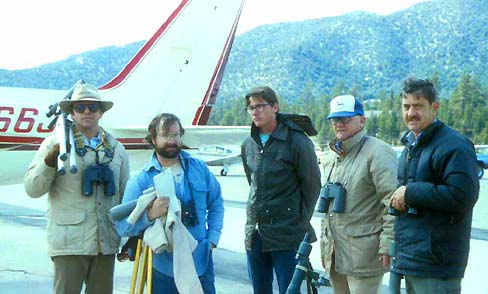 On
28 Apr 1984, the California Big Day team that had tied the Texas record
the previous year undertook another Big Day using an airplane. They
followed
the same route as before but without the press and without R.T.
Peterson.
This time they set the unquestioned single-state Big Day record with
243
species. Shown in front of the plane at the Big Bear airport are (L to
R) Jeri Langham, Don Roberson, John Parmeter, Mike Parmeter, and Laurie
Binford. On
28 Apr 1984, the California Big Day team that had tied the Texas record
the previous year undertook another Big Day using an airplane. They
followed
the same route as before but without the press and without R.T.
Peterson.
This time they set the unquestioned single-state Big Day record with
243
species. Shown in front of the plane at the Big Bear airport are (L to
R) Jeri Langham, Don Roberson, John Parmeter, Mike Parmeter, and Laurie
Binford.
Also that spring, although no active birder would
learn of it for months,
California's first
Ruby-throated Hummingbird was netted and
collected
at U.C. Davis's Sagehen Creek field station, Nevada Co., 15 May.
|
A major step forward in bird identification was the
publication of Lars
Jonsson's art and Peter Grant's text on small Calidris
sandpipers
("stints") in the July 1984 issue of British Birds (below; BB
77: 293-315).
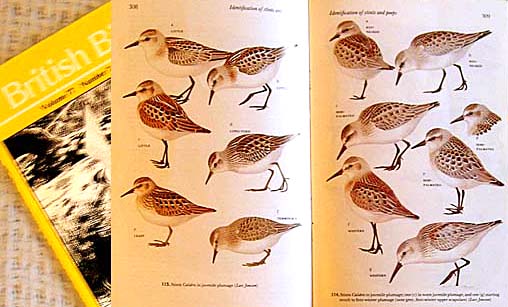 By now, numerous American birders were taking this journal. Although
many
of the ageing and i.d. principles published had been known to top
observers
for several years, this paper was a watershed event for the broader
public.
These same plates, but with Dick Veit's text, were also published in
the
Oct 1984 issue American Birds (AB 38: 853-876). Where
Peter
Grant had taught that ageing gulls was the key to identification,
Jonsson
and colleagues explained that the same was true for waders. [An earlier
European book —Prater, Marchant & Vuorinen's Guide to the
identification
and ageing of Holarctic Waders (1977) — had been very influential
on
both sides of the Atlantic in developing these principles.] Now we
learned
that, if a bird were properly placed in an age-class or plumage state,
details of specific feathers — tertials, greater coverts, scapulars —
might
separate even the rarest vagrant from its nearest congeners. This was
eye-opening
stuff!
By now, numerous American birders were taking this journal. Although
many
of the ageing and i.d. principles published had been known to top
observers
for several years, this paper was a watershed event for the broader
public.
These same plates, but with Dick Veit's text, were also published in
the
Oct 1984 issue American Birds (AB 38: 853-876). Where
Peter
Grant had taught that ageing gulls was the key to identification,
Jonsson
and colleagues explained that the same was true for waders. [An earlier
European book —Prater, Marchant & Vuorinen's Guide to the
identification
and ageing of Holarctic Waders (1977) — had been very influential
on
both sides of the Atlantic in developing these principles.] Now we
learned
that, if a bird were properly placed in an age-class or plumage state,
details of specific feathers — tertials, greater coverts, scapulars —
might
separate even the rarest vagrant from its nearest congeners. This was
eye-opening
stuff!
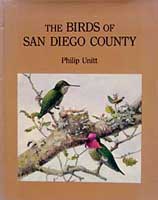 Another
important publication in 1984 was Phil Unitt's The Birds of San
Diego
County, published as a formal memoir of the San Diego Natural
History
Museum (right). It was the first major avifaunal review for any of the
State's 58 counties, and was rich in detail of specimen-backed locality
records throughout this large and impressive county. Unitt is
interested
in subspecific variation, and this work contains original research and
a broad scope of review on this topic. Another
important publication in 1984 was Phil Unitt's The Birds of San
Diego
County, published as a formal memoir of the San Diego Natural
History
Museum (right). It was the first major avifaunal review for any of the
State's 58 counties, and was rich in detail of specimen-backed locality
records throughout this large and impressive county. Unitt is
interested
in subspecific variation, and this work contains original research and
a broad scope of review on this topic.
Birders at the Salton Sea contributed some unbelievable
finds this summer
— seabirds inland! Curtis Marantz had a Sooty Shearwater and an
Ancient
Murrelet at the north end 16 June, both second records inland. Guy
McCaskie had a Leach's Storm-Petrel there 30 June, and the
highlight
was a Cook's Petrel at the north end off and on from 24-29
July
(Steve Cardiff, Donna Dittmann). It was previously known only far
offshore
or as a coast-cast specimen. These finds would eventually be repeated
but,
at the time, were astonishing.
Paul DeBenedictis, writing for the national journal American
Birds,
had suggested that "a revelation of the real size of a Palearctic
component
in the avifauna of the Americas will be a significant contribution to
ornithology
by birders during this decade." We have already seen some evidence for
this in the early years of the 1980s. Autumn 1984 would add much more:
two new California records, another considered the "first unambiguous,"
and a first mainland record of eastern Palearctic migrants. In northern
California, a Brown Shrike banded 20 Sep on S.E. Farallon I.
(1st
CA rec; photo below left © Phil Henderson) was good news
(but
unattainable to birders), but a chasable Dusky Warbler (2nd CA
rec,
first for the mainland) was better news. Discovered by John Luther at
Hayward
Regional Shoreline 28 Sep, it was still through the next day for dozens
of observers (photo below right © Al Ghiorso).
In southern California, an adult White Wagtail of the race ocularis
was near Pt. Piedras Blancas, San Luis Obispo Co., 5-8 Oct (Greg P.
Smith).
It was also chasable and was considered a first unambiguous State
record
of ocularis at the time, although, in retrospect, it appears
that
one or more of the juvenal wagtails that were recorded in the 1970s
were
also of this race (still split from
M. lugens by the A.O.U.).
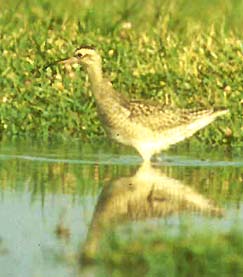
These were all impressive, but they paled compared to the Little
Curlew found by Paul Lehman in the Santa Maria valley of northern
Santa
Barbara County on 16 Sep (photo, right, 22 Sep © Alan
Hopkins).
At the time Paul was chasing a Curlew Sandpiper found earlier in the
day
(Louis Bevier), so the curlew is an example of the famed 'Patagonia
Rest
Stop' phenomena. Not only was this a California first, but a new bird
for
the entire Western Hemisphere — a species with a long migration route
but
a small world population, a species not found in any North American
guide
of any type. It proved to be in juvenal plumage, and thus, like most
other
fall vagrants, had made a navigational error during its first flight
south.
It wandered throughout the flooded fields of the river valley for a
month,
remaining to 14 Oct. During the latter half of its stay it favored a
field
owned by local ranchers, the Mahoneys, who permitted access to hundreds
of birders. Paul Lehman & Jon Dunn wrote up the scientific paper
("A
little-known species reaches North America." Amer. Birds 39:
247-250,
1985) but Brad Schram's account of the event, entitled
"Mahoney's
Curlew," remains entertaining reading (Birding 17:15-18, 1985).
Yet two other birds representing first State records
occurred that autumn,
although it would take years to sort out that fact. A Ruddy
Ground-Dove
at China Ranch, Inyo Co., from 31 Aug-29 Sep 84 (Jan Tarble) and
another
at Iron Mt. Pump Station, San Bernardino Co., 11 Oct-3 Nov (Bill
Wagner)
would prove to be the first of an invasion of this species to
California
that would lead to nesting pairs in the 21st century. And a poorly seen
but interesting adult gull on 30 Dec (Kurt F. Campbell), studied over
the
first three weeks of 1985 (Campbell, R. Stallcup, D. DeSante et al.) at
Bodega Bay, would turn out to be the State's first acceptable Iceland
Gull., L. g. kumlieni. This taxa would remain
controversial
for taxonomic reasons (Is it a hybrid swarm with Thayer's Gull? If so,
how recently evolved? Is hybridization still occurring? If so, where
and
how do we know? Is it a stable taxa?) and California reports would be
subjected
to hyper-critical review for years, despite evidence that birds
originating
within the breeding range of kumlieni were regularly occurring
in
tiny numbers each winter, but that's another story for a different
place.
Meanwhile, the State's 2nd Lesser Black-backed Gull lounged at
the
south end of the Salton Sea from 18 Dec-5 Jan (Jon Dunn).
To close out the memorable year, a Mottled Petrel was
watched
close to the kelp line at Pt. Pinos, Monterey Co., on 12 Dec, as it
battled
40 mph winds and made its way west against the gale (Don Roberson).
|
|
1985
| After the gulls of winter, the first real excitement
for 1985 did not
occur until 13 Apr, when a birding group that included Brian Daniels
and
Loren Hays found a a spring overshoot Common Black-Hawk
circling
over Thousand Palms Oasis, Riverside Co., another California first. A Black-backed
Wagtail from Ron LeValley's back yard overlooking the Mad R.
estuary,
Humboldt Co., was a remarkable 'yard bird' 13 May. Northern California
got its first Spotted Redshank the next day at Crescent City
(Dick
Erickson), refound 15 May at Lake Earl, Del Norte Co. (it was in full
alternate
plumage; given its exceptional rarity in California — one prior record
in '84 — and the fact it was in adult plumage, it is possible this was
the same bird as at the Salton Sea last spring). A Red-footed Booby
flew around Morro Rock, San Luis Obispo Co., 27 May (John Schmitt; 1st
for southern Calif., 3rd for State).
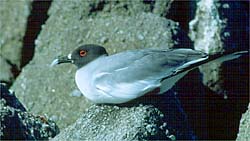 In
Monterey Bay, millions of pelagic red crabs were washing up on local
beaches,
providing a feast for local gulls. The red crabs had invaded Monterey
Bay
with the 'once-in-a-century' El Niño of '83-84, and now, with
the
waters cooling, they were all dying. The long arm of El Niño was
never more apparent than in early June 1985 in Monterey Bay. On 6 June,
Alan Baldridge was walking to his office at Hopkins Marine Station, on
the shore of Monterey Bay, and did a double-take. Sitting among the
nesting
Western Gulls in a small colony just offshore was an adult Swallow-tailed
Gull, an endemic to the Galapagos Islands (photo right
©
Peter LaTourrette). The regional editors for Amer. Birds wrote:
"This fantastic bird roosted on the rocks by day, became more active
late
in the day, and presumably flew out to sea at night to feed, returning
about 7:30 a.m. on June 7. It was rediscovered at Moss Landing June 8.
The origin of this gull was predictably controversial. Theories ranged
from a delayed result of El Niño to ship-assisted passage." In
Monterey Bay, millions of pelagic red crabs were washing up on local
beaches,
providing a feast for local gulls. The red crabs had invaded Monterey
Bay
with the 'once-in-a-century' El Niño of '83-84, and now, with
the
waters cooling, they were all dying. The long arm of El Niño was
never more apparent than in early June 1985 in Monterey Bay. On 6 June,
Alan Baldridge was walking to his office at Hopkins Marine Station, on
the shore of Monterey Bay, and did a double-take. Sitting among the
nesting
Western Gulls in a small colony just offshore was an adult Swallow-tailed
Gull, an endemic to the Galapagos Islands (photo right
©
Peter LaTourrette). The regional editors for Amer. Birds wrote:
"This fantastic bird roosted on the rocks by day, became more active
late
in the day, and presumably flew out to sea at night to feed, returning
about 7:30 a.m. on June 7. It was rediscovered at Moss Landing June 8.
The origin of this gull was predictably controversial. Theories ranged
from a delayed result of El Niño to ship-assisted passage."
The Swallow-tailed Gull may have been the most
controversial bird in
State history, with opinion split between those who thought it a wild
vagrant
— and just about the best bird to reach California — and those who
preferred
to await a "pattern of occurrence." That pattern was established when
another
adult Swallow-tailed Gull was seen 15 miles off the Farallones on 3 Mar
1996, during a warm-water decade that led to another major El
Niño
in '97-98. With the appearance of the 2nd record, the 1985 bird was
finally
unanimously accepted by the CBRC. Even in an ordinary year,
Swallow-tailed
Gulls migrate as far south (36 degrees) as Monterey Bay is to the
north,
and a vagrant could reach us. However, to date, the two California
birds
were associated with major El Niño phenomena in the eastern
tropical
Pacific when much of the world's population is dispersed from their
normal
routes when their food supply in the Peru Current collapses. A
specialized
night-feeder gull whose breeding biology resembles that of terns, there
is no evidence that this species has been in captivity or even could be
a ship-assisted captive.
Jon Dunn found a Louisiana Waterthrush at Deep
Springs, Inyo
Co., 7 Aug (2nd CA rec). John Mariani, using the new information on
stint
i.d. (see 1984), found a juvenal Little Stint at Moonglow
Dairy,
Moss Landing, Monterey Co., on 10 Sep. It was chased by locals, missed,
rediscovered days later, and finally become a crowd favorite through 21
Sep at this private working dairy (below; photos © D.
Roberson),
which graciously permitted birder access.
| Both the Swallow-tailed Gull and the Little Stint
just made it into
press for the late 1985 publication of Monterey Birds by
Don Roberson, the second serious avifaunal review of an interesting
California
county.
On 25 Oct, the State's third Spotted Redshank,
this one in juvenal
plumage, was found in the Santa Maria valley (Louis Bevier). It was
successfully
chased by locals that afternoon, so many birders headed that direction
to try the next day. Then tragedy struck. A car carrying birders was
broadsided
by a truck at an intersection in the bottoms, and long-time Santa Cruz
observer Carolyn Fredricksen was killed. In all the miles, over all the
long chases throughout the era, this was the only fatality linked to a
bird chase. It devastated the bird world.
|
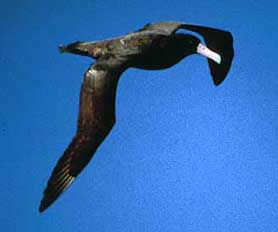 Rich
Stallcup was leading a boat trip to the Cordell Bank, off Marin Co., on
3 Nov when a huge dark albatross with a bubble-gum pink bill glided in
behind the boat. "Short-tailed Albatross!," cried Rich. It was indeed,
just the 2nd modern record after the species nearly went extinct during
World War II. Some photos showed it wore a band from Torishima I.,
Japan,
the only remaining nesting colony. A hastily arranged chase trip went
out
from Bodega Bay in rough weather on 5 Nov, carrying many of the State's
top listers. After almost everyone was sea-sick, the near-mythical
young
Short-tailed
Albatross appeared (right; photo © Don Roberson). It
was
"truly awe inspiring," read my notes; we note in passing that an
unprecedented
45 (!) Wilson's Storm-Petrels were also recorded that trip. Rich
Stallcup was leading a boat trip to the Cordell Bank, off Marin Co., on
3 Nov when a huge dark albatross with a bubble-gum pink bill glided in
behind the boat. "Short-tailed Albatross!," cried Rich. It was indeed,
just the 2nd modern record after the species nearly went extinct during
World War II. Some photos showed it wore a band from Torishima I.,
Japan,
the only remaining nesting colony. A hastily arranged chase trip went
out
from Bodega Bay in rough weather on 5 Nov, carrying many of the State's
top listers. After almost everyone was sea-sick, the near-mythical
young
Short-tailed
Albatross appeared (right; photo © Don Roberson). It
was
"truly awe inspiring," read my notes; we note in passing that an
unprecedented
45 (!) Wilson's Storm-Petrels were also recorded that trip.
In the last week of the year, a few Common
Redpoll were appearing
in extreme northeastern California. Over the next 3 weeks, over 20 were
found between Tule Lake and Lower Klamath NWRs. Jon Dunn photographed
this
one (below left) at Tule Lake on 31 Dec. This was the first
redpoll
incursion in a century, so State birders began the long, cold trek
north.
Among them were Arnold Small and Herb & Olga Clarke, who flew to
Klamath
Falls, Oregon, and rented a car. They were up before dawn, driving the
icy roads to get to the site early. In the bitter cold they hit a patch
of "black ice" and flipped the car, rolling it over completely and
landing
back upright. Shaken but undeterred — after all this was the first
chasable
Common Redpoll in the State! — they continued on. Just a few of us were
there when they arrived in a badly banged up rental (below right).
But this story had a happy ending — everyone got the redpoll.
|
|
|
1986
 While
debate would rage over the prior Bodega Bay gull, and every other claim
of Iceland Gull in California, this extreme pale-end glaucoides-like
juvenal gull at the Otay Dump, San Diego Co., 17-26 Jan 1986 (Dale
Delaney;
photo right © Arnold Small) seemed to satisfy even the
toughest
critic. While
debate would rage over the prior Bodega Bay gull, and every other claim
of Iceland Gull in California, this extreme pale-end glaucoides-like
juvenal gull at the Otay Dump, San Diego Co., 17-26 Jan 1986 (Dale
Delaney;
photo right © Arnold Small) seemed to satisfy even the
toughest
critic.
In April, several research cruises off the
California coast reported
dark
Pterodroma petrels, variously identified as
Solander's or Murphy's
Petrels. A boat trip to the Cordell Banks 1 June had 7 more such birds,
again with various labels. It took years, and much further experience,
before it became evident that all had been Murphy's Petrels —
new
to the State list — and that this little-known species is actually of
regular
occurrence far offshore in spring and early summer.
|
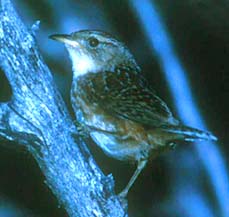 Summer
1986 produced several unexpected birds. First was a Whip-poor-will on
Pt. Reyes 6 June (Gjon Hazard, Rich Stallcup), a first to coastal
northern
California. Then Ray Ekstrom found a singing Sedge Wren on
territory
in the Little Shasta Valley, Siskiyou Co., during a breeding bird
survey
for a 2nd State record. It would remain almost a month (photo left
©
Herb Clarke). On 9 June, a most unexpected Red-headed Woodpecker
made a brief visit to Pt. St. George in the extreme northwest corner of
California (Jeff Kingery). Summer
1986 produced several unexpected birds. First was a Whip-poor-will on
Pt. Reyes 6 June (Gjon Hazard, Rich Stallcup), a first to coastal
northern
California. Then Ray Ekstrom found a singing Sedge Wren on
territory
in the Little Shasta Valley, Siskiyou Co., during a breeding bird
survey
for a 2nd State record. It would remain almost a month (photo left
©
Herb Clarke). On 9 June, a most unexpected Red-headed Woodpecker
made a brief visit to Pt. St. George in the extreme northwest corner of
California (Jeff Kingery).
On 31 Aug, Rich Stallcup added another species to
the State list when
he (and a boatload of birders) photographed a light-morph Wedge-tailed
Shearwater several miles off Pt. Pinos in Monterey Bay. This would
be the first of several records of this, and other, warm-water
procelarids
that would reach central California during the warm-water decades of
the
'80s and '90s.
In early Sep, the long-anticipated Eurasian
Dotterel was found
in short-grass fields on Pt. Reyes (David Holway, Durrell Kapan). The
youngster
would be ogled by many from 6-9 Sep (photo below 7 Sep ©
Don
Roberson). It represented a 2nd State record (the first had been on the
Farallones in Sep 1974).
|

|
| In southern California, good birds of the fall
included a Gray-cheeked
Thrush at Pt. Loma on 1 Oct (1st southern CA rec; Richard Webster);
a Groove-billed Ani on 25 Oct at Seeley, Imperial Co. (3rd CA
rec;
Phil Unitt); and at year's end, a visiting birder described a male Xantus's
Hummingbird from Yaqui Wells, San Diego Co., which, when accepted,
was another State first (Richard Klauke). This hummer is a Baja
California
endemic, and would make much bigger news in 1988. |
 In
northern California, the State's 1st Chuck-will's-widow was
picked
up injured at Half Moon Bay, San Mateo Co., 16 Oct (and became a
specimen
at the California Academy of Sciences). Then the State's 2nd (and first
chasable) Purple Gallinule was present 17-26 Oct at a park in
Fremont,
Alameda County (Alice Hoch). The next month, visiting Oregon birder
Mike
Denney would find a shrike at Whitehouse Pool, Pt. Reyes, on 28 Nov
that
puzzled him; he thought it might be a Brown Shrike but the word was not
circulated locally. It was found independently on the Pt. Reyes CBC and
reported as a Northern Shrike. It wasn't until three weeks after the
initial
sighting that Kevin Hintsa would look for this shrike and discover that
it actually was a Brown Shrike (photo left © Rich
Stallcup)
— a Siberian vagrant that represented the 2nd State record and the
first
for the mainland (the first having been banded on the Farallones in
1984).
It would remain to 26 Apr to be seen by all who wished. In
northern California, the State's 1st Chuck-will's-widow was
picked
up injured at Half Moon Bay, San Mateo Co., 16 Oct (and became a
specimen
at the California Academy of Sciences). Then the State's 2nd (and first
chasable) Purple Gallinule was present 17-26 Oct at a park in
Fremont,
Alameda County (Alice Hoch). The next month, visiting Oregon birder
Mike
Denney would find a shrike at Whitehouse Pool, Pt. Reyes, on 28 Nov
that
puzzled him; he thought it might be a Brown Shrike but the word was not
circulated locally. It was found independently on the Pt. Reyes CBC and
reported as a Northern Shrike. It wasn't until three weeks after the
initial
sighting that Kevin Hintsa would look for this shrike and discover that
it actually was a Brown Shrike (photo left © Rich
Stallcup)
— a Siberian vagrant that represented the 2nd State record and the
first
for the mainland (the first having been banded on the Farallones in
1984).
It would remain to 26 Apr to be seen by all who wished.
Farther north in Humboldt County, an Oriental
Greenfinch of a
northeast Siberian race foraged with a flock of House Finches at the
Arcata
wastewater ponds facility on 5 Dec (John Sterling); it would remain to
3 Apr. Although the evidence seemed quite favorable to it being a wild
vagrant, some expressed concern about the chances it was an escapee
from
captivity (birds of the Japanese race are regularly kept cage birds).
This
dispute was never settled; eventually the CBRC relegated it to the
limbo
of a "supplemental" list. Given the other Siberian species that reached
California this fall, however, some still consider this a perfectly
fine
addition to the State list.
Finally, yet another species was added to
California's wintering warblers
when a Blackburnian discovered in Pacific Grove, Monterey Co.,
29
Dec remained until 22 Mar (Don Roberson).
|
|
|
1987
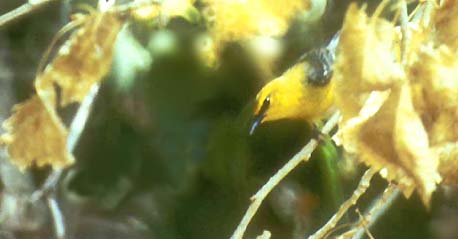 After
a rather quiet winter, spring 1987 had some nice warblers. By now, of
course,
even superb finds like Golden-winged or Blue-winged Warbler
would not be bold-faced in American Birds; after all, by late
May
1987 the State had accumulated 32 records of the former, and six of the
latter. But never before or since have both species been in the same
tree
in California. Over 29-30 May a male Golden-winged (John Wilson) and a
female Blue-winged (Jon Dunn) spent a fair bit of time in the same
cottonwood
at Butterbredt Springs, Kern Co. (photo right of the Blue-winged
© John Wilson). The other major spring highlight was the State's
2nd
Violet-crowned
Hummingbird near Saugus, L.A., 25-29 May (Laura Vance). After
a rather quiet winter, spring 1987 had some nice warblers. By now, of
course,
even superb finds like Golden-winged or Blue-winged Warbler
would not be bold-faced in American Birds; after all, by late
May
1987 the State had accumulated 32 records of the former, and six of the
latter. But never before or since have both species been in the same
tree
in California. Over 29-30 May a male Golden-winged (John Wilson) and a
female Blue-winged (Jon Dunn) spent a fair bit of time in the same
cottonwood
at Butterbredt Springs, Kern Co. (photo right of the Blue-winged
© John Wilson). The other major spring highlight was the State's
2nd
Violet-crowned
Hummingbird near Saugus, L.A., 25-29 May (Laura Vance). |
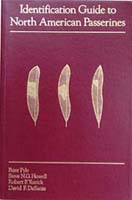 A
major step forward in bird identification occurred with the publication
of the Identification Guide to North American Passerines
by Peter Pyle, Steve Howell, Robert Yunick, and Dave DeSante (left).
Although
aimed primarily at bird-banders, its detailed analysis of age, sex, and
i.d. criteria for American landbirds was a major achievement, matched
only
by the Svensson guide in Europe. A
major step forward in bird identification occurred with the publication
of the Identification Guide to North American Passerines
by Peter Pyle, Steve Howell, Robert Yunick, and Dave DeSante (left).
Although
aimed primarily at bird-banders, its detailed analysis of age, sex, and
i.d. criteria for American landbirds was a major achievement, matched
only
by the Svensson guide in Europe.
In fall, Rich Stallcup found a wild behaving Crested
Caracara
feeding on a lamb carcass in the Mono Basin, Mono Co., 13 Sep. It was
chased
successfully by some but more often missed by others through 16 Oct.
Again
there was a major debate about its origin: wild or escaped captive? The
CBRC eventually placed it in a "supplemental list" limbo, pending other
records [the species was not officially added to the "main" list until
2005]. Researchers on the Farallones banded another Dusky Warbler
(California's 3rd) on 14 Oct. Guy McCaskie found southern California's
2nd Gray-cheeked Thrush at Pt. Loma on 2 Oct; this time this
representative
of a very skittish species remained 'chasable' for a week.
|
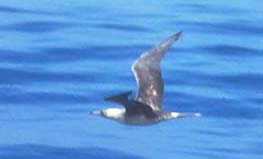 The
most significant bird event of the autumn was a most unexpected influx
of Red-footed Boobies to coastal California. A half-dozen or so
occurred between October and early December (not everyone agreed on the
i.d. of every booby), but the Red-foots ranged from light morphs (e.g.,
one 3 mi off Santa Barbara I. on 11 Oct, photo right ©
K.L.
Garrett) to dark morph birds. One in San Francisco Bay was eventually
entangled
in fishing line and taken to a local SPCA. Nothing like this had
occurred
before, and it was presumably related to the major increases in sea
surface
temperatures off California during the '80s and '90s, book-ended by the
great El Niños of '82-83 and '97-98. The
most significant bird event of the autumn was a most unexpected influx
of Red-footed Boobies to coastal California. A half-dozen or so
occurred between October and early December (not everyone agreed on the
i.d. of every booby), but the Red-foots ranged from light morphs (e.g.,
one 3 mi off Santa Barbara I. on 11 Oct, photo right ©
K.L.
Garrett) to dark morph birds. One in San Francisco Bay was eventually
entangled
in fishing line and taken to a local SPCA. Nothing like this had
occurred
before, and it was presumably related to the major increases in sea
surface
temperatures off California during the '80s and '90s, book-ended by the
great El Niños of '82-83 and '97-98. |
|
|
1988
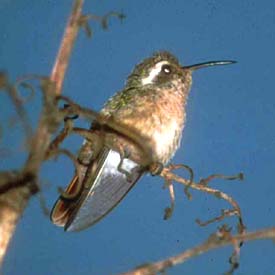 The
year began with a famed vagrant from the tip of Baja California. A Broad-billed
Hummingbird (a very good vagrant) had been frequenting Virgil
Ketner's
yard in Oxnard, Ventura Co., since Nov. Kem Hainebach went to look for
it and discovered California's first chasable Xantus's Hummingbird
(photo left © Arnold Small). It was actually a second
State
record (see 1986) but hundreds of birders got to see this one. The
female
built a nest but eventually abandoned it (and the yard) by 27 Mar. The
year began with a famed vagrant from the tip of Baja California. A Broad-billed
Hummingbird (a very good vagrant) had been frequenting Virgil
Ketner's
yard in Oxnard, Ventura Co., since Nov. Kem Hainebach went to look for
it and discovered California's first chasable Xantus's Hummingbird
(photo left © Arnold Small). It was actually a second
State
record (see 1986) but hundreds of birders got to see this one. The
female
built a nest but eventually abandoned it (and the yard) by 27 Mar.
Little else made news until summer, when a dark-morph Wedge-tailed
Shearwater was studied at the north end of the Salton Sea, of all
places,
on 31 July (2nd State rec.; Richard Webster, Guy McCaskie).
In autumn, the State's only Little Curlew — now an
adult — made
a brief appearance in the Santa Maria bottoms 23-24 Sep (Mike
Lippsmeyer).
But over the course of the last three months of 1988 a stream of
vagrants
that breed in northeast Asia made appearances throughout California in
an unprecedented fallout that surpassed even the "Siberian Express" of
1983-1984. Here are the highlights (photos of first State records
follow
the list):
-
Terek Sandpiper at Carmel SB, Monterey Co., 28
Aug-23 Sep (1st State
rec; Erika Wilson, Bette Harriman). Photo below left 29 Aug
©
Peter LaTourrette
-
Long-toed Stint at Salinas wtp, Monterey Co., 29
Sep-2 Sep (1st
State rec; Brian Daniels, Michael Patten). Photo below center
29
Aug © Peter LaTourrette
-
Hudsonian Godwit at Carmel 28 Aug & Salinas
R. mouth 4 Sep-3
Oct (Shawneen Finnegan; this Arctic breeder is not a Siberian bird)
-
Bar-tailed Godwit at Salinas R. mouth 11 Sep
(S.F. Bailey)
-
Gray Wagtail at Salinas R. mouth 9-10 Oct (1st
State rec; David
Sibley). Photo below right 10 Oct © Stephen F. Bailey
-
Northern Wheatear near Kirkland, Tehama Co.,
13-15 Oct (3rd State
record, first 'chasable;" Steve Laymon)
-
Spotted Redshank in the San Joaquin Co. delta
19-20 Nov (4th State
rec; Mike Lippsmeyer, Tim Manolis, Jeri M. Langham)
-
Little Stint collected at Harper Dry Lake, San
Bernardino Co., 21
Nov (3rd State rec; Eugene Cardiff)
-
Rustic Bunting at Half Moon Bay, San Mateo Co.,
25-27 Nov (2nd State
rec; Ron Thorn)
-
Whooper Swan at Venice I., San Joaquin Co., 16
Dec (2nd State rec;
Mike Lippsmeyer)
|
Yet these were not the only rarities in the State. Coming from the
other
direction, northern California had three different Yellow-green
Vireos.
Flying from somewhere to the east, a Red-headed Woodpecker (4th
State rec; Karen Bridgers) made a very unexpected visit to Goleta,
Santa
Barbara Co., 14 Sep (photo above left © Don Roberson). The
woodpecker remained until April 1989; Karen Bridgers' entertaining
account
on "The joy of finding the bird" appeared in Birding 21:
269-270.
And from somewhere down Mexico way, a Least Grebe visited the
Warm
Water Fish Hatchery at the south end of the Salton Sea 19 Nov-24 Dec
(John
Menge; photo above right © Arnold Small). This was a 2nd
California
record and the first for everyone who went to look at it. The State's
first
and previously only record was a family group collected on the Colorado
River back in 1946. |
 1988
also saw the publication of David Gaines' Sierran and Great Basin
avifauna
Birds
of Yosemite and the East Slope. This was a major update and
upgrade
from his Birds of the Yosemite Sierra (1977). Now enlivened
with
art by Keith Hansen, this summary of status and distribution was
lyrically
written in memorable prose. Sadly, David Gaines did not live to see its
publication. He was tragically killed in an automobile accident in
January
1988, not far from his beloved Mono Lake. His work, and that of the
Mono
Lake Committee that he founded, would eventually save Mono Lake from
becoming
a dead sea due to the incessant water diversions by the City of Los
Angeles,
which owned water rights. It was not until 1994 — a full 20 years after
Gaines first became interested in Mono Lake — that Mono Lake would be
saved
by State orders restricting diversions and setting minimum stream flows
and lake levels. "Save Mono Lake" read the bumper sticker on many a
birder's
car in the 1980s. The fulfillment of that dream was one of the great
environmental
victories of the late 20th century. 1988
also saw the publication of David Gaines' Sierran and Great Basin
avifauna
Birds
of Yosemite and the East Slope. This was a major update and
upgrade
from his Birds of the Yosemite Sierra (1977). Now enlivened
with
art by Keith Hansen, this summary of status and distribution was
lyrically
written in memorable prose. Sadly, David Gaines did not live to see its
publication. He was tragically killed in an automobile accident in
January
1988, not far from his beloved Mono Lake. His work, and that of the
Mono
Lake Committee that he founded, would eventually save Mono Lake from
becoming
a dead sea due to the incessant water diversions by the City of Los
Angeles,
which owned water rights. It was not until 1994 — a full 20 years after
Gaines first became interested in Mono Lake — that Mono Lake would be
saved
by State orders restricting diversions and setting minimum stream flows
and lake levels. "Save Mono Lake" read the bumper sticker on many a
birder's
car in the 1980s. The fulfillment of that dream was one of the great
environmental
victories of the late 20th century. |
|
|
1989
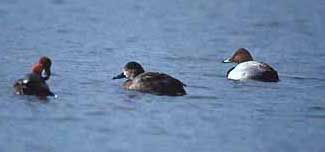 After
the excitement of the previous year, 1989 passed relatively quietly.
The
male Common Pochard that frequented Silver Lakes, San
Bernardino
Co., 11-17 Feb (first State record, Robert Potvliege; photo
left
© D. Roberson, with two Redheads) might be considered the final
passenger
on the Express. But unrelated to that phenomena was a road-killed Chuck-will's-widow
at Loleta, Humboldt Co., 4 Jan (2nd State rec). After
the excitement of the previous year, 1989 passed relatively quietly.
The
male Common Pochard that frequented Silver Lakes, San
Bernardino
Co., 11-17 Feb (first State record, Robert Potvliege; photo
left
© D. Roberson, with two Redheads) might be considered the final
passenger
on the Express. But unrelated to that phenomena was a road-killed Chuck-will's-widow
at Loleta, Humboldt Co., 4 Jan (2nd State rec). |
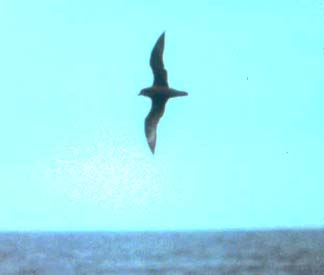 Richard
Spight offered his private yacht for a major ornithological expedition
in late April, to be led by Steve Bailey, Peter Pyle, and David Yee.
Decent
weather permitted a cruise a hundred miles offshore from Marin to
Mendocino
counties, and the results were impressive: 98 Murphy's Petrels
(one of them collected to satisfy even the museum ornithologists;
another
photo'd, right, © S.F. Bailey), 113 Cook's Petrels,
and 136 Horned Puffins. This decade, like the last, would end
with
major pelagic findings. Richard
Spight offered his private yacht for a major ornithological expedition
in late April, to be led by Steve Bailey, Peter Pyle, and David Yee.
Decent
weather permitted a cruise a hundred miles offshore from Marin to
Mendocino
counties, and the results were impressive: 98 Murphy's Petrels
(one of them collected to satisfy even the museum ornithologists;
another
photo'd, right, © S.F. Bailey), 113 Cook's Petrels,
and 136 Horned Puffins. This decade, like the last, would end
with
major pelagic findings.
Back on the mainland, the State added a new
breeding species when several
nests of Franklin's Gull were found at Lower Klamath NWR in
July
(S.F. Bailey).
|
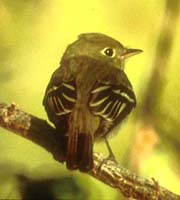 Autumn
1989 did not nearly have the diversity of the previous year, but it was
not without highlights. Jon Dunn found a Yellow-bellied Flycatcher
at Galileo Hill, Kern Co., that vocalized and was well documented
(e.g.,
photo left © Matt Heindel). It was a 6th State record, but
only the second for the mainland, and as it lingered 27 Sep-1 Oct, it
became
the first really 'chasable' one [although some, like your humble
narrator,
were out-of-State and missed it anyway]. More dramatic and unexpected
was
yet another Siberian landbird captured on S.E. Farallon I. on 1 Nov: a
Red-flanked
Bluetail (Dave Beadle), another California first from this magic
rock.
The year — and the decade — would end with another interesting
landbird:
a Field Sparrow at Irvine, Orange Co. 25 Nov-6 Jan 1990 (John
O'Brien,
Becky Boyd). It was a 2nd State record, the first having been — yes,
you
guessed it — on the Farallones back in 1969. Autumn
1989 did not nearly have the diversity of the previous year, but it was
not without highlights. Jon Dunn found a Yellow-bellied Flycatcher
at Galileo Hill, Kern Co., that vocalized and was well documented
(e.g.,
photo left © Matt Heindel). It was a 6th State record, but
only the second for the mainland, and as it lingered 27 Sep-1 Oct, it
became
the first really 'chasable' one [although some, like your humble
narrator,
were out-of-State and missed it anyway]. More dramatic and unexpected
was
yet another Siberian landbird captured on S.E. Farallon I. on 1 Nov: a
Red-flanked
Bluetail (Dave Beadle), another California first from this magic
rock.
The year — and the decade — would end with another interesting
landbird:
a Field Sparrow at Irvine, Orange Co. 25 Nov-6 Jan 1990 (John
O'Brien,
Becky Boyd). It was a 2nd State record, the first having been — yes,
you
guessed it — on the Farallones back in 1969. |
 Throughout
the decade of the '80s, significant progress was made on a series of
grid-based
Breeding
Bird Atlas projects at the county level. Combined, these volunteer
efforts would add a wealth of knowledge about the breeding birds of
California.
Marin County was the first to undertake a Breeding Bird Atlas, under
the
leadership of Dave Shuford. Data were collected from 1976-1982, and the
Marin
County Breeding Bird Atlas was published a decade later. Field work
for other atlases began in the 1980s in Orange (1985), Sonoma (1986),
San
Bernardino (1987), Santa Cruz (1987), Monterey (1988), Santa Clara
(1988),
Sacramento (1988), Napa (1989), and San Luis Obispo (1989) counties.
Field
work would finish for all these projects in the early 1990s, and other
counties would start their atlases then. The photo (right)
shows the four atlases from the 1970s and 1980s that were published in
the '90s: Marin (Shuford 1993), Monterey (Roberson & Tenney 1993),
Sonoma (Burrdige 1995), and Orange (Gallagher 1997). Napa published
their
atlas in 2003 and several others are currently (2005) heading toward
publication. Throughout
the decade of the '80s, significant progress was made on a series of
grid-based
Breeding
Bird Atlas projects at the county level. Combined, these volunteer
efforts would add a wealth of knowledge about the breeding birds of
California.
Marin County was the first to undertake a Breeding Bird Atlas, under
the
leadership of Dave Shuford. Data were collected from 1976-1982, and the
Marin
County Breeding Bird Atlas was published a decade later. Field work
for other atlases began in the 1980s in Orange (1985), Sonoma (1986),
San
Bernardino (1987), Santa Cruz (1987), Monterey (1988), Santa Clara
(1988),
Sacramento (1988), Napa (1989), and San Luis Obispo (1989) counties.
Field
work would finish for all these projects in the early 1990s, and other
counties would start their atlases then. The photo (right)
shows the four atlases from the 1970s and 1980s that were published in
the '90s: Marin (Shuford 1993), Monterey (Roberson & Tenney 1993),
Sonoma (Burrdige 1995), and Orange (Gallagher 1997). Napa published
their
atlas in 2003 and several others are currently (2005) heading toward
publication. |
|